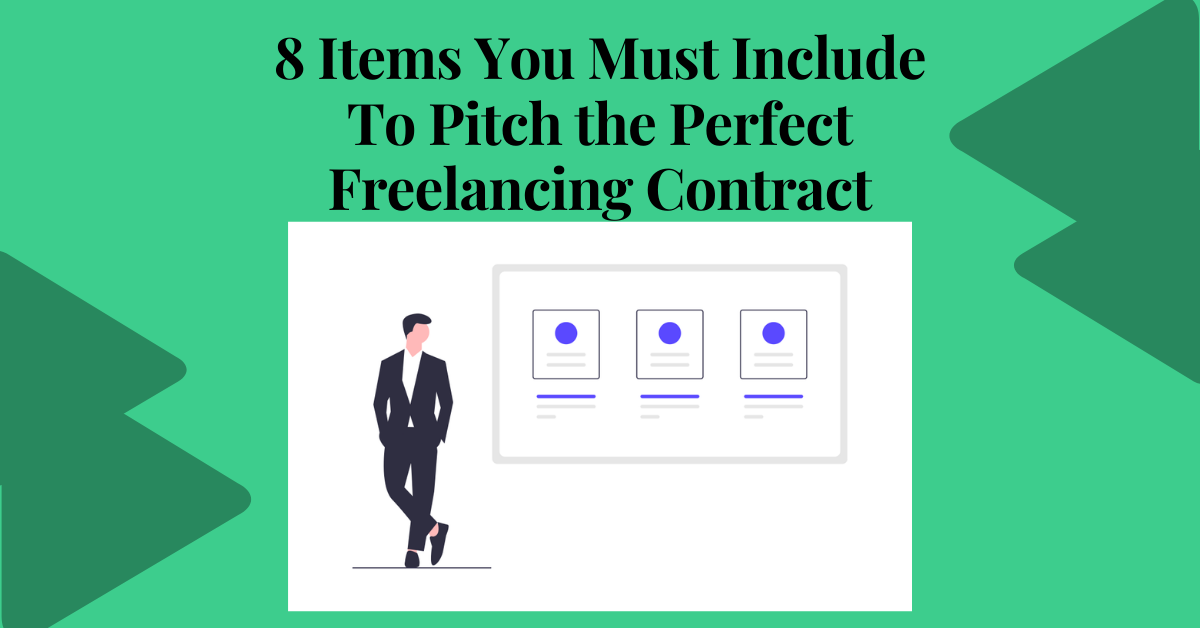As a freelancer, you will quickly learn the importance of pitching and winning business. While freelancers utilize many different types of contracts during freelancing, there are some things that you must include across the board to ensure you enter into any new work with a clear understanding of what’s expected. Freelancing contracts are there to protect both you and your client, so you need to ensure they’re clear and detailed and they cover all of the necessary points. Here are eight items you must include in the perfect freelancing contract.
1. A clear understanding of the gig
When you’re negotiating with a client, it’s likely that they will ask lots of questions and make different suggestions about the work they’re asking you to do. There’s a lot of information for you to take in and understand, so you need to make sure you have a clear and accurate picture of what your client is expecting.
Within your contract, you should include a clear description of the gig, which includes bullet points of all the work to be carried out. You could perhaps even include notable things that aren’t included to save any confusion or misunderstanding. When you have clearly articulated the gig, your client will read it and confirm or ask for amendments. It’s much better that this is done at the start as opposed to when the project is delivered.
2. Clear goals and objectives
Within your contract, you should clearly articulate the goals and objectives that will be achieved. The objectives you list should clearly match the expectations of the client, as they will use this as an indication that you have fully understood what is expected of you. It’s particularly impressive if you can link the project objectives to your client’s overall business goals.
Understanding how a specific project contributes to the overarching business goals of a client further displays your understanding of how important your work is and that you are able to complete the task accordingly. When listing objectives and goals in the contract, ensure they are SMART so your client can run through them and ensure you’re both on the same page.
3. Specify how you will fulfil the contract
Your client will want to understand exactly how you’re going to carry out the specified work. In this section, clarity is vital, and you might like to include the following:
- Which software will you use to complete the task? (if appropriate)
- What are the project milestones – how often will you deliver each part of the project?
- How will you share the delivery with the client?
- Will you offer any revisions as part of the agreed price?
- When will you deliver the completed project by?
The more specific you are about how you will deliver the project, the less space you leave for misunderstandings or miscommunication. You will increase your chances of winning business if clients can see that you are carefully planning their work and are serious about delivering on time.
4. Be clear with your pricing
Pricing is perhaps the area that presents the most difficulties between freelancers and clients. When crafting a contract, you need to be very clear about what your prices are. Don’t be tempted to price yourself too low just to get the work, as this might count against you. When setting your pricing, think about the following:
- Is your price an hourly rate or a one-off fee for final delivery?
- If you offer any revisions, are they free, or how much will you charge?
- Do you offer expedited delivery at an additional fee?
- What gig extras do you offer, and how can they be negotiated?
Where possible, you should break your pricing down into clear sections and offer an explanation for why you have priced the gig in this way. It will save lots of back-and-forth communication with your client and will also show that you’re professional and considered with your gig contracts.
5. Be explicit with your timeline
When articulating your gig timeline, it’s not enough to simply say the gig will be delivered on (x) date. You need to be specific and think about as many things as possible to ensure your client will be satisfied with what you suggest. When working out your gig’s timeline, you should include the following:
- When exactly will the final project be delivered? (You need to think about different time zones when thinking about the final delivery).
- What are the project milestones? Some projects need to be delivered in phases, so be specific about what needs to be delivered and when, as well as how it will be delivered.
- What is the best way to communicate throughout the project? Do you have specific office hours that you can be contacted in?
If you’re not explicit with the delivery timeline, you’re running the risk of miscommunication between you and your client, so make sure you include as much information as possible in the gig contract.
6. Include past work highlights
While you don’t need to tell potential clients about every single project you’ve ever worked on, you should include a handful of relevant pieces of work that you’ve completed in the past to show them that you’re capable of doing the work you’re pitching for. If possible, include screenshots or links as part of the contract, so the client can see for themselves what work you’ve undertaken, and they can then judge if they think it’s of sufficient quality to offer you the work.
7. Provide verifiable client testimonials
Equally as important as past work highlights, including client testimonials, builds trust and confidence with new clients and shows that you’re capable of doing the work you’re pitching for. Where possible, only include client testimonials from credible sources that can be verified by your clients. If you simply list a testimonial in a word document, they have no way of knowing if it’s legitimate or whether you’ve just made it up. External links work well and give clients the chance to verify what your clients have said about your work quality.
8. Clearly articulate the next steps
The final thing you need to include in your contract is the next steps. This doesn’t have to be overly long or comprehensive; you just need to specify how you will get the project underway and what information you need from the client to get started. Make sure you mention how best to communicate so you can get things started. When you’ve submitted the pitch, be mindful to check your email or profile regularly so you can respond to clients in a timely manner if they decide that you’re the right person to take on the work.
Conclusion
When you pitch for a freelancing contract, you need to make sure you’re explicitly clear about what services you can offer, as well as showing confidence that you’re capable of getting the job done. Don’t forget; you only get one chance to make a good first impression, so make sure your pitch does you justice and exemplifies your professionalism. These eight items should form the foundation of any freelancing contract you pitch and will give you the best chance of securing business from new clients.

